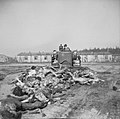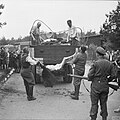Bergen-Belsen concentration camp
Appearance
Bergen-Belsen was a Nazi concentration camp during World War II. An estimated 50,000 prisoners died there, as well as 20,000 Soviet prisoners of war (POWs).[1] Up to 35,000 of them died of typhus just before and after the camp was liberated (freed).[2]
Liberation
[change | change source]The camp was liberated on 15 April 1945 by British soldiers.[3] Inside the camp, the British soldiers found 60,000 living people,[2] and 13,000 dead bodies lying on the ground, unburied.[3] The scenes were horrific. They were described by the BBC's Richard Dimbleby, who was with the British soldiers:
| “ | Here over an acre of ground lay dead and dying people. You could not see which was which ... The living lay with their heads against the corpses and around them moved the awful, ghostly procession of emaciated, aimless people, with nothing to do and with no hope of life, unable to move out of your way, unable to look at the terrible sights around them ... Babies had been born here, tiny wizened things that could not live ... A mother, driven mad, screamed at a British [soldier] to give her milk for her child, and thrust the tiny [baby] into his arms, then ran off, crying terribly. He opened the bundle and found the baby had been dead for days. This day at Belsen was the most horrible of my life.[4] | ” |
—Richard Dimbleby | ||
Notable inmates
[change | change source]Photo gallery
[change | change source]-
British Army soldiers free the camp on April 15, 1945
-
Women survivors in Bergen-Belsen, April 1945
-
Former camp guards are forced to load the bodies of dead prisoners onto a truck for burial, April 17–18, 1945
-
Nazi Dr. Fritz Klein stands amongst corpses in Mass Grave 3
-
A crowd watches the last camp hut be destroyed
Related pages
[change | change source]References
[change | change source]- ↑ Oppenheimer, Paul (1996). From Belsen to Buckingham Palace. Nottingham: Quill Press. ISBN 0-9536280-3-5.
- ↑ 2.0 2.1 "Bergen-Belsen", United States Holocaust Memorial Museum.
- ↑ 3.0 3.1 "The 11th Armoured Division (Great Britain)", United States Holocaust Memorial Museum.
- ↑ "Richard Dimbleby, "Liberation of Belsen", BBC News, April 15, 1945". BBC News. April 15, 2005. Retrieved May 3, 2013.






